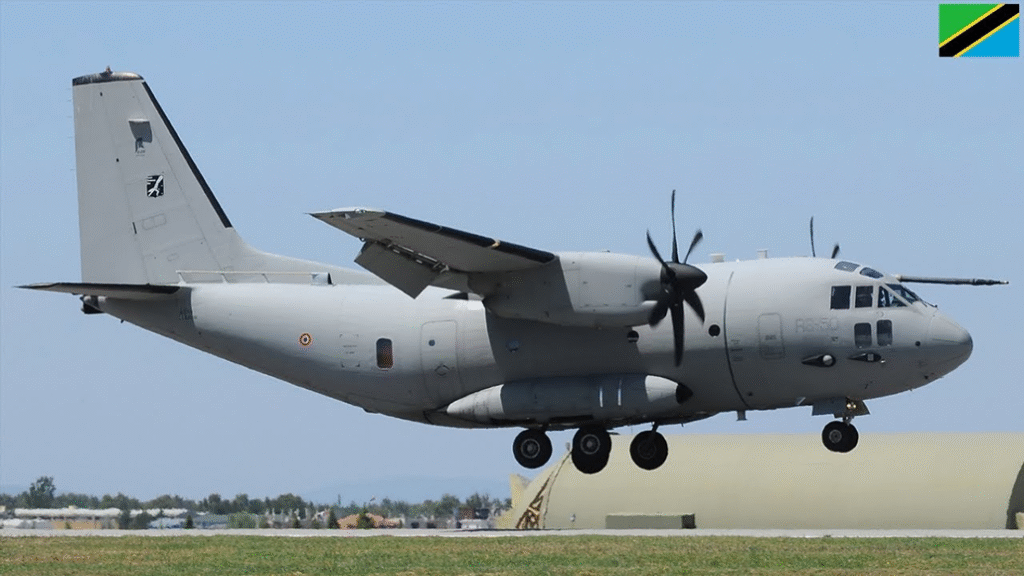Tanzania has made notable investments in new transport aircraft to improve its capacity to conduct humanitarian operations, disaster response, and regional support missions. This shift in strategy reflects the Tanzanian government’s commitment to expanding the non-combat functions of its air force, particularly in response to increased natural disasters, regional displacement crises, and medical emergencies.
The acquisition of modern airlift platforms has allowed the Tanzania People’s Defence Force (TPDF) to evolve beyond traditional military operations and take on a more prominent role in humanitarian assistance and disaster relief (HADR) efforts, both domestically and within East Africa.

The Need for Enhanced Air Mobility
- Tanzania’s geography—characterized by vast distances, underdeveloped road infrastructure in rural regions, and a high frequency of natural disasters like floods and droughts—has long demanded greater air mobility. The COVID-19 pandemic exposed serious gaps in the country’s logistical capabilities, especially when it came to distributing medical supplies, evacuating patients, and delivering emergency aid.
- Additionally, the instability in neighboring countries such as Mozambique and the Democratic Republic of Congo (DRC) has resulted in refugee movements into Tanzanian territory, further stretching the country’s humanitarian infrastructure. Recognizing these challenges, the government prioritized investments in versatile air transport platforms capable of delivering supplies quickly and efficiently in diverse operational environments.
Acquisitions and Fleet Expansion
- Tanzania initiated procurement deals aimed at strengthening its air transport fleet. Among the most significant acquisitions were fixed-wing utility and cargo aircraft designed to carry personnel, medical supplies, food aid, and construction equipment to remote or crisis-affected regions.
- Aircraft such as the C-27J Spartan and CASA C-295 were reportedly evaluated, with the latter believed to have been selected for its proven track record in both military and civilian airlift missions across Africa. The CASA C-295, for example, offers a strong balance of range, payload, and adaptability to rugged runways, making it ideal for austere airstrips in rural Tanzania.
- These new platforms have been integrated into the TPDF Air Wing’s logistics command, replacing aging Soviet-era aircraft that had become increasingly costly to maintain and limited in functionality.
Supporting Humanitarian and Disaster Relief Operations
- Tanzania’s new airlift capability has already made a tangible impact in the field. During flooding events in the southern and western regions in 2022 and 2023, the air force successfully transported food, water purification systems, tents, and emergency medical teams to displaced populations. In some cases, aircraft were also used to evacuate vulnerable communities before floodwaters reached dangerous levels.
- During a cholera outbreak in the Lake Zone, transport aircraft played a key role in delivering vaccines and deploying rapid response health teams. Their ability to bypass impassable roads allowed for faster containment of the disease and ensured supplies reached health facilities in a matter of hours rather than days.
- Beyond Tanzania’s borders, the upgraded transport fleet has supported regional humanitarian missions coordinated under the African Union and the East African Community (EAC). For instance, in partnership with international relief organizations, the TPDF air wing participated in airlifting aid to refugee camps in northern Mozambique and South Sudan, reinforcing Tanzania’s reputation as a regional contributor to peace and stability.

Training, Maintenance, and Local Capacity Building
- To complement the new fleet, Tanzania invested in training programs for aircrew, logistics personnel, and ground technicians. Some pilots and maintenance crews received specialized instruction abroad, while others were trained at revamped domestic facilities under a joint initiative with partner countries and aerospace firms.
- The goal has been to ensure that the new aircraft are not only operable but also sustainable over the long term. Maintenance agreements with aircraft manufacturers include the establishment of local service hubs, reducing downtime and dependency on foreign repair centers.
- These efforts have helped to strengthen Tanzania’s broader air logistics capacity, making the TPDF more self-reliant and responsive in emergencies.
Diplomatic and Regional Implications
- Tanzania’s aviation modernization has been positively received by regional partners and international donors. The country’s increased ability to deliver humanitarian assistance has elevated its status within regional organizations and enhanced its diplomatic influence.
- Moreover, the investment aligns with Tanzania’s long-standing policy of non-alignment and peaceful regional engagement. Rather than emphasizing combat operations, the focus on humanitarian logistics reflects a soft-power approach to security, emphasizing service delivery and cooperative regional leadership.
Conclusion
Tanzania’s investment in new transport aircraft marks a strategic shift toward enhancing its humanitarian response capabilities and regional support role. By upgrading its airlift capacity, the TPDF has positioned itself as a key actor in both domestic disaster relief and multinational humanitarian missions. As challenges from climate change, public health emergencies, and forced migration continue to grow, the country’s strengthened aviation assets will play a vital role in safeguarding lives and promoting regional stability.


